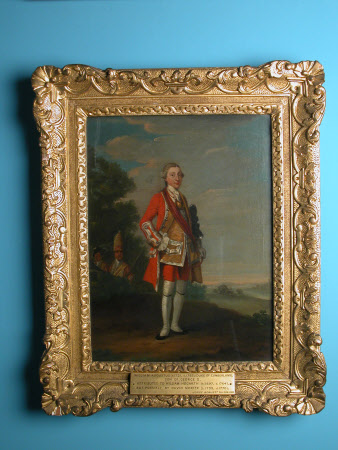Portrait of an Officer, formerly identified as Prince William Augustus, Duke of Cumberland (1721–1765)
attributed to David Morier (Berne 1705 – London 1770)
Category
Art / Oil paintings
Date
1750 - 1751
Materials
Oil on canvas
Measurements
457 x 330 mm
Place of origin
England
Order this imageCollection
Osterley Park and House, London
NT 771249
Summary
Oil painting on canvas, Portrait of an Officer, formerly identified as Prince William Augustus, Duke of Cumberland (1721–1765), attributed to David Morier (Berne 1705 – London 1770). Full-length portrait of a man wearing orange waistcoat and red coat. Right hand in waistcoat pocket, helmet under left arm. In background landscape and two military figures. On its acquisition as part of the Jones Bequest in 1882 this painting was identified as a portrait by William Hogarth (1697-1764) of William Augustus, Duke of Cumberland (1721-1765), son of King George II. This attribution was accepted by Austin Dobson in his book William Hogarth (1902, p.178 and 1907, p.209). A note on the museum object file made by Basil Long in 1913 challenges this attribution and observes that it is closer in style to the work of the artist David Morier (1701/2-1770). In this note Basil Long also suggests that the figure does not represent William, Duke of Cumberland. The subject matter is typical of Morier. Born in Bern, Switzerland, Morier came to England following an introduction with his future patron, William Augustus, Duke of Cumberland in 1743. He is best known for his paintings of soldiers, which, like 589-1882, show in detail each regiment's uniform (collections principally at Windsor Castle and Wilton House). A number of these were made a series. In 1751, following the issue of the first British uniform regulations, Morier was made Limner to the duke with a salary of £100. At this time he also embarked on a series showing soldiers in uniforms, including the light dragoon regiments. When the Duke of Cumberland died in 1765, his second home, Cranbourn Lodge, Berkshire, housed 106 of these paintings and only works by the artists were displayed in the picture gallery. Morier's work varies in quality. This is due to the fact the he probably employed assistants to help supply to the high demand for his work. The composition, placing the soldier in the foreground on a knoll of a hill, against a landscape of distant hills, is employed frequently by the artist... A comparison of the posture of the sitter in 589-1882 with that of Private, Reg. of Horse 4B "Pöllnitz" shows the artist's interest in creating an elegant figure. In both these paintings the sitter rests his weight on his left leg, which is furthest from the viewer, whilst placing his right arm either on his hip or, in the case of the painting in Windsor, against his face whilst resting his elbow on the horse by his side. The V&A portrait shows detailed observation of the officer's uniform, something which occurs frequently in Morier's work. Andrew Cormack has suggested that Portrait of an Officer dates to 1750-1751, and therefore executed at the same time as the series of Grenadiers of the British Army house at the Royal Collection Windsor (see letter dated 2008 on object file). A comparison with the style of this painting with those in Windsor supports this dating. In the same letter Andrew Cormack notes that, whilst it is not possible to identify the regiment of the officer from the uniform that he is wearing, it can plausibly be linked to one of four regiments; the 34th Foot, 29th Foot, 46th Foot, or the 38th Foot. All these regiments wore red coats with yellow facings. However Cormack notes that the portrait might be of a regiment of which nothing is known of the uniform, therefore remaining difficult to identify. [From V&A description]
Provenance
On loan from V&A (Jones Bequest)
Makers and roles
attributed to David Morier (Berne 1705 – London 1770), artist previously catalogued as attributed to William Hogarth (London 1697 - London 1764), artist
